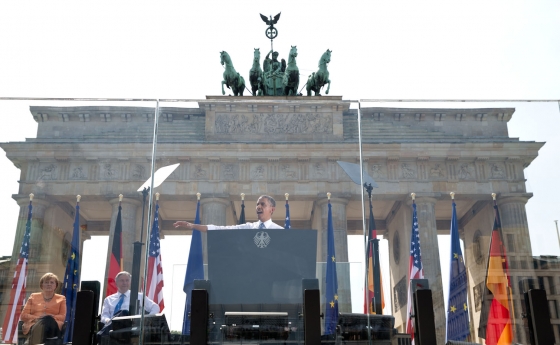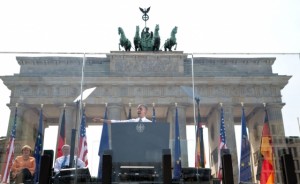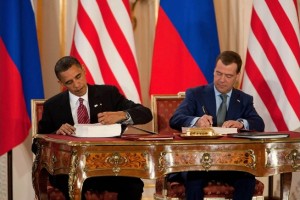
Berlin and the Nature of Possible Future Nuclear Weapons Reductions
Last week in Berlin, President Obama set the stage for a new round of nuclear arms reduction negotiations saying that:
“After a comprehensive review, I have determined that we can ensure the security of America and our allies and maintain a strong and credibility strategic deterrent while reducing our deployed strategic nuclear weapons by up to one-third….I intend to seek negotiated cuts with Russia to move beyond Cold War nuclear postures.”
These are reductions that would be made on top of those already included in the New START treaty which brings the levels of deployable American nuclear weapons down to 1,550; this new level would be roughly 1,000 deployed strategic nuclear weapons, though several have argued that this level may actually be closer to 1,100.
 President Obama in stating, “We may not live in fear of nuclear annihilation — but as long as nuclear weapons exist, we are not truly safe” can be seen clearly harkening back to sentiments he expressed at his 2008 speech in Berlin while he was then Senator Obama when he pushed for the cause of a nuclear free world and “to reduce the arsenals from another era.” Indeed, many observers will note a continuance of the President’s Prague agenda.
President Obama in stating, “We may not live in fear of nuclear annihilation — but as long as nuclear weapons exist, we are not truly safe” can be seen clearly harkening back to sentiments he expressed at his 2008 speech in Berlin while he was then Senator Obama when he pushed for the cause of a nuclear free world and “to reduce the arsenals from another era.” Indeed, many observers will note a continuance of the President’s Prague agenda.
Statements from both Administration and Russian officials give some idea of how this process might continue and evolve in future nuclear arms reductions.
Russian officials have signaled their wish that any further reductions in nuclear weapons become multilateral affairs, no longer just bilateral agreements between the U.S. and the Russian Federation.
Assistant Secretary of State for International Security and Nonproliferation Thomas Countryman, speaking at George Washington University’s Elliott School of International Affairs on June 18th, expressed a similar sentiment in his statements; that the U.S. is seeking to eventually move disarmament talks from bilateral discussions between the U.S. and the Russian Federation to multilateral discussions with all nuclear armed states.
Multilateral negotiations and reductions, despite their complexity, are a worthy long-term goal. However, with the U.S. and Russia possessing the largest nuclear forces in the world President Obama’s course on pursuing more direct talks with the Russian Federation about additional reductions is the correct course for now. Many of the other nuclear armed states will most likely only engage in such a multilateral reduction discussion when the nuclear arsenals of the U.S. and Russia are approaching a level similar to theirs; at current New START levels the U.S. and Russia will by 2022 have stockpiles of 4,800 and 3,500 respectively compared to current stockpiles of 300 in France, 250 in China, and 225 in Britain.
Many non-nuclear weapons states have been pushing for fast and drastic across-the-board decreases in nuclear armaments for humanitarian reasons and have been dissatisfied with the current incremental pace of reductions. Still, Assistant Secretary Countryman made it quite clear that this incremental system of negotiated arms reductions is the U.S.’s preferred route and that the “progress (made) is in fact quite impressive.” Given that at the end of the Cold War the U.S. and the Soviet Union had 10,000 and 9,000 deployed strategic nuclear weapons respectively which have been reduced to 1,550 and 1,330 respectively via the New START treaty, this progress over the last twenty plus years has been quite impressive.
The game changing nature of nuclear weapons means unfortunately that they, along with other strategic technologies like prompt global strike and cyber warfare, will remain part of modern statecraft for the foreseeable future. Still, recognizing the dangers to the planet that nuclear weapons represent President Obama in his June 19th Berlin speech has taken another step forward in mitigating this threat.
While President Obama’s wish may be for a nuclear weapons free world in the role of President, he and his administration are also realists. This new offer of an additional round of reductions to Russia is a promising step towards further decreases in the total nuclear weapons, while maintaining a credible deterrent. Through incremental steps such as the START treaties and this new proposed round of reductions it is possible that a world with significantly fewer total nuclear arms may be possible in the next few decades.
Christopher Smith is a PhD student at the University of Arizona’s Department of Chemistry and Biochemistry with a focus on Analytical Chemistry.






